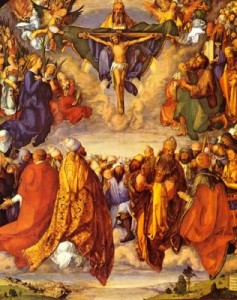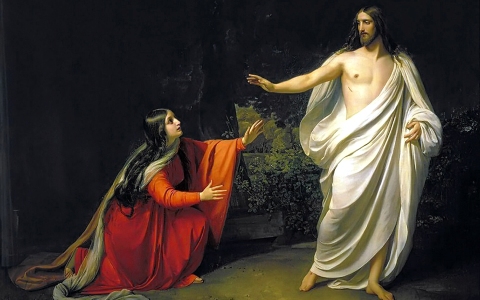
Communion of Saints
When I was a little girl, I loved to curl up on the sofa and flip through my favorite book of 365 saints, reading random stories that caught my interest. One particular saint always held my attention. Her name was St. Thecla, and the illustration for her biography depicted a beautiful young girl with long flowing hair, staring rapturously toward heaven. She was tied to a stake and clearly about to be burned. Despite that horrible prospect, it was apparent that St. Thecla viewed her cruel fate as a minor obstacle to finally meeting her Creator.
Ironically, Thecla’s own mother and father were responsible for her death sentence. They were not at all pleased that their daughter had converted to Christianity after meeting St. Paul in Iconium during the 1st century A.D. She had made a pledge of virginity and refused to marry the rich and handsome nobleman whom Thecla’s parents had chosen for her to marry. They disowned Thecla and reported her as a Christian. She was sentenced to death by burning.
As the flames began to burn higher and inched toward the delicate feet of the courageous maiden, a sudden storm appeared on the horizon. A torrent of rain quickly extinguished the fire, leaving St. Thecla unharmed. Temporarily freed, Thecla disguised herself as a boy and quietly left Iconium to follow St. Paul. When safely far from home, she abandoned her disguise and continued to travel with the Apostle.
When they reached Antioch, a nobleman relentlessly pursued Thecla despite her refusals of his attention. The rejected suitor lay in wait and attempted to assault her. Determined to keep her virginity intact, St. Thecla fought so hard that she ended up assaulting him, greatly amusing the residents of Antioch. The humiliated young man brought charges against Thecla, and she found herself facing yet another death sentence. This time her fate was even more brutal—death by wild beasts.
Thecla walked bravely into the arena. The crowd held its breath as the animals stealthily approached her, then gasped as the savage beasts quietly laid down by her feet and began licking them gently.
The frustrated officials tried one last time to bring about St. Thecla’s death by lowering her into a snake pit. Predictably, they pulled her out hours later completely unharmed. An astonished official had the young virgin brought before him and asked, “Who are you, that you are always saved?”
Proudly, Thecla replied, “I am a daughter of Christ, Son of the living God. He alone is the Way, the Truth and the Life; He is the one who protects me. To Him be glory and power for ever and ever.” The official had no choice but to simply set her free. The beautiful virgin’s bravery and the miracles worked on her behalf did not go unnoticed and resulted in many conversions to Christianity.
Thecla quickly rejoined St. Paul’s group, committed to spreading the Good News of the gospels. At some point, she left the group to dwell in a cave, living a monastic life and dying peacefully at the age of 90.
St. Thecla is regarded by many as the first virgin martyr of the early Church despite the fact that she did not technically die a martyr’s death. Since she courageously faced certain death not once, but at least three times, she certainly shows a martyr’s heroic faith.
Appropriately, St. Thecla is the patron of the dying. Her name is still invoked in the litany prayed during the rites for the dying and in the Church’s official prayer for a departing soul:
As Thou didst deliver the holy virgin and martyr Thecla from three most gruesome torments, so deliver the soul of this Thy servant; and let him (her) enjoy with Thee the blessings of heaven. Amen.”
St. Thecla’s feast day is September 23rd. She recently made the news when the oldest icon of St. Paul was found in her catacomb in Rome. She is easily recognized in statues and artwork which depict a beautiful young girl surrounded by wild beasts.












